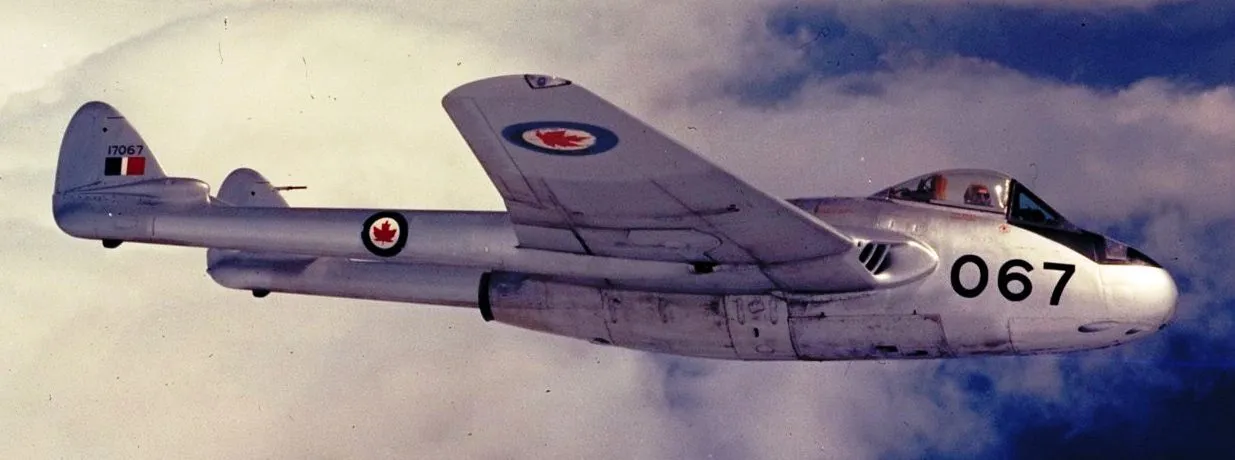McLachlan, John Norman
Killed in Flying Accident 1952-09-12


Birth Date: 1923-April-06
Born: Petrolia, Ontario
Son of Norman and Gladys McLachlan of Brights Grove, Ontario.
Home: Petrolia, Ontario
Enlistment: London, Ontario
Enlistment Date: 1942-10-13
Service
RCAF
Unit
1 FIS- Flying Instructor School
Base
Rank
Flying Officer
Position
Flying Officer
Service Numbers
17914
Home
 Petrolia, Ontario
Petrolia, Ontario
First Burial
 Lake View Cemetery, Sarnia, Ontario, Canada
Lake View Cemetery, Sarnia, Ontario, Canada
de Havilland Vampire

de Havilland DH.100 Vampire, RCAF (Serial No. 17067), No. 411 "County of York" Squadron (Auxiliary), Toronto, Ontario
The de Havilland Vampire is a British jet fighter which was developed and manufactured by the de Havilland Aircraft Company. It was the second jet fighter to be operated by the RAF, after the Gloster Meteor, and the first to be powered by a single jet engine.
Development of the Vampire as an experimental aircraft began in 1941 during the Second World War, to exploit the revolutionary innovation of jet propulsion. From the company's design studies, it was decided to use a single-engine, twin-boom aircraft, powered by the Halford H.1 turbojet (later produced as the "Goblin"). Aside from its propulsion system and twin-boom configuration, it was a relatively conventional aircraft. In May 1944 it was decided to produce the aircraft as an interceptor for the Royal Air Force (RAF). In 1946 the Vampire entered operational service with the RAF, only months after the war had ended.
The Vampire quickly proved to be effective and was adopted as a replacement of wartime piston-engined fighter aircraft. During its early service it accomplished several aviation firsts and achieved various records, such as being the first jet aircraft to cross the Atlantic Ocean. The Vampire remained in front-line RAF service until 1953 when it was progressively reassigned to various secondary roles, such as ground attack and pilot training, for which specialist variants were produced. The RAF retired the Vampire in 1966 when its final role of advanced trainer was filled by the Folland Gnat. The Royal Navy had also adapted the type as the Sea Vampire, a navalised variant suitable for operations from aircraft carriers. It was the service's first jet fighter.
The Vampire was exported to a wide variety of nations and was operated worldwide in numerous theatres and climates. Several countries deployed the type in combat during conflicts, including the Suez Crisis, the Malayan Emergency, and the Rhodesian Bush War. By the end of production, almost 3,300 Vampires had been manufactured, a quarter of these having been manufactured under licence in several other countries.
The layout of the DH.100 used a single jet engine installed in an egg-shaped fuselage which was primarily composed of plywood for the forward section and aluminium throughout the aft section. It was furnished with conventional mid-mounted straight wings; air brakes were installed on the wings to slow the aircraft, a feature that had also been incorporated in the Meteor. Armament comprised four 20 mm Hispano Mk V cannon located underneath the nose; from the onset of the design phase, even when the aircraft was officially intended to serve only as an experimental aircraft, the provision for the cannon armament had been included.
In 1946, a single Vampire F.1 began operating on an evaluation basis in Canada at the Winter Experimental Establishment in Edmonton. The Vampire F.3 was selected as one of two types of operational fighters for the Royal Canadian Air Force (RCAF) and was first flown in Canada on 17 January 1948 where it went into service as a Central Flying School training aircraft at RCAF Station Trenton. Operating a total of 86 aircraft, the Vampire F.3 became the first jet fighter to enter RCAF service in any significant numbers.
The Vampire had the function of introducing Canadian fighter pilots not only to jet propulsion, but also to other amenities such as cockpit pressurisation and the tricycle landing gear arrangement. It proved to be a popular aircraft, being easy to fly and often considered a "hot rod". In Canadian service, the Vampire served in both operational and air reserve units (400, 401, 402, 411, 438 and 442 squadrons). During the late 1950s, the type was retired and was replaced in RCAF service by the Canadair Sabre.Wikipedia
After retirement, 26 of the surplus RCAF Vampires were sold to the Formetal Division of Fliteways Inc., West Bend, Wisconsin, USA in 1958. Another 4 airframes were to provide spares. Aerial Blight Control, also of West Bend, refurbished 15 Vampires for sale to the Mexican Air Force starting in 1959. The FAM operated the Vampires until about 1970. Several of the remaining Vampires purchased by Fliteways found their way to the US civil market. Some may now be found in museums in Mexico, the U.S. or Canada.
 Canadian Virtual War Memorial
Canadian Virtual War Memorial www.findagrave.com
www.findagrave.com Wikipedia de Havilland Vampire
Wikipedia de Havilland Vampire Harold A Skaarup Web Page
Harold A Skaarup Web Page YouTube de Havilland Vampire
YouTube de Havilland Vampire de Havilland Vampire - Kestrel Publications
de Havilland Vampire - Kestrel Publications